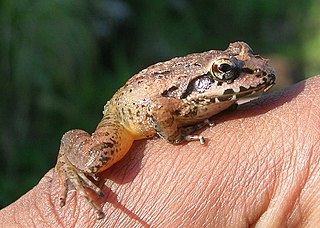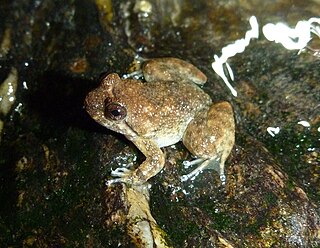
Occidozyga is a genus of frogs in the family Dicroglossidae found in southeastern Asia between eastern India, southern China, and Java. They sometimes go under the common name Java frogs or floating frogs.

Indirana semipalmata is a species of frog endemic to the Western Ghats region of southern India. They are small frogs, reaching lengths of about 36 mm (1.4 in) from snout to vent. The species breeds during the monsoons, laying their eggs on moist rocks and tree bark. Their tadpoles are terrestrial - hatching, feeding, and undergoing metamorphosis without ever entering any standing bodies of water.

Kaloula baleata, the flower pot toad or sometimes the smooth-fingered narrow-mouthed frog, is a species of narrow-mouthed toad. It is native to India, Borneo, Indochinese Peninsula, Java, Malay Peninsula and Philippines where it lives in lowland rainforests and is tolerant of disturbed sites. The IUCN lists it as being of "Least Concern".

Wallace's flying frog, also known as the gliding frog or the Abah River flying frog, is a moss frog found at least from the Malay Peninsula into western Indonesia, and is present in Borneo and Sumatra. It is named for the biologist, Alfred R. Wallace, who collected the first known specimen.
Beck's tree frog is a species of frogs in the family Pelodryadidae. It is endemic to Papua New Guinea. Its natural habitats are tropical moist montane forests, grasslands and streams. It was first described by the British biologist and herpetologist Arthur Loveridge in 1945 and is named in honour of the American ornithologist and explorer Rollo Beck who led the Whitney South Seas Expedition in the 1920s, collecting bird and other specimens from thousands of islands in the South Pacific.
Nyctimystes fluviatilis, also known as the Indonesian big-eyed tree frog, is a species of frog in the family Pelodryadidae, also treated as the subfamily Pelodryadinae in the family Hylidae. It is endemic to New Guinea and is known from Idenburg River and Wapoga River in Papua province, Indonesia, and from the Torricelli Mountains in the East Sepik Province and Kavorabip in the Western Province, both in the western Papua New Guinea.
Hyperolius igbettensis is a species of frog in the family Hyperoliidae. It is found in West Africa from Guinea eastward to Liberia, Ivory Coast, Ghana, Togo and Benin, Nigeria, and into Central Africa at least to Cameroon but likely further east to the Central African Republic and southwestern Chad; the eastern border of distribution of this species relative to other members in the Hyperolius nasutus complex is unclear. Common name Igbetti long reed frog has been coined for it. The type locality is near Igbetti, a village in Oyo State, Nigeria.
Megophrys parallela is a species of frog in the family Megophryidae. It is endemic to Sumatra and known from a number of localities on mountains along the island's western coast where it is expected to have a wide distribution.
Limnonectes shompenorum is a species of frog in the family Dicroglossidae. It is found in Great Nicobar Island (India), its type locality, and in western Sumatra (Indonesia). It is similar to Limnonectes macrodon. The name refers to Shompen people, the indigenous people of the interior of Great Nicobar Island.

Nannophrys guentheri is an extinct species of frog in the family Dicroglossidae. It was endemic to Sri Lanka. The species was first identified in 1882 by George Boulenger and named after the German-born British zoologist Albert Günther. It is not known where in Sri Lanka the specimens were found.
The small-headed frog or tiny oriental frog is a species of frog in the family Dicroglossidae. It is endemic to the Philippines where it is found on Mindanao, Basilan, and in the Sulu Archipelago.

Occidozyga semipalmata is a species of frog in the family Dicroglossidae. It is endemic to western and northern Sulawesi, Indonesia. It has been found in Gunung Lombobatang Natural Reserve, Lore Lindu National Park, and Bogani Nani Wartabone National Park.
Djoko Tjahjono Iskandar is an Indonesian herpetologist who studies the amphibians of Southeast Asia and Australasia. He is a professor of biosystematics and ecology at Bandung Institute of Technology in West Java, Indonesia.
Chalcorana parvaccola is a species of "true frog" in the family Ranidae. It is endemic to Sumatra, Indonesia. It was split off from Chalcorana chalconota by Robert Inger and colleagues in 2009, along with a number of other species. The specific name parvaccola is derived from Latin parvus meaning small and accola meaning neighbor, and refers to this species being smaller than its "neighbor", the related Sumatran species Chalcorana rufipes.
Chalcorana rufipes is a species of "true frog" in the family Ranidae. It is endemic to Sumatra, Indonesia. It was split off from Chalcorana chalconota by Robert Inger and colleagues in 2009, along with a number of other species. The specific name rufipes is derived from Latin rufus meaning reddish and pes meaning foot, in reference to the reddish tinge on the underside of the pedal webbing in life.
Alcalus rajae, sometimes known as king dwarf mountain frog, is a species of frog in the family Ceratobatrachidae, subfamily Alcalinae. It is endemic to Kalimantan, Borneo (Indonesia), and known from its type locality in the Bukit Baka Bukit Raya National Park, as well as the Gunung Penrissen Nature Reserve, both in the West Kalimantan province, and from the Meratus Protected Forest in the South Kalimantan province. The specific name rajae refers to the type locality: Bukit Raya is the highest mountain in Kalimantan, getting its name from the Indonesian word raya, signifying the majestic size of the peak. It also alludes to the relatively large size of this species relative to its (then) congeners.
Meristogenys maryatiae, also known as Maryati's torrent frog, is a species of frog in the family Ranidae. It is endemic to the state of Sabah, in the Malaysian part of Borneo. The specific name honours Prof. Datin Mohamed Maryati, entomologist from the Universiti Malaysia Sabah, who helped the describers of this species during their herpetological surveys in Sabah.

Leptobrachella bondangensis is a species of frog in the family Megophryidae. It is endemic to Central Kalimantan, in the Indonesian part of Borneo, and is only known from its eponymous type locality, Mount Bondang in the Murung Raya Regency. Common name Bondang dwarf litter frog has been coined for this species.
Gracixalus seesom, also known as the orange bush frog or orange bushfrog, is a species of frog in the family Rhacophoridae. It is endemic to northwestern Thailand and is known from the Kanchanaburi and Chiang Mai Provinces.
Pulchrana fantastica, also known as the splendid stream frog, is a species of "true frog", family Ranidae. It is endemic to northern Sumatra (Indonesia) and is currently known from the Aceh and North Sumatra provinces. Its nearest relatives are Pulchrana centropeninsularis and Pulchrana siberu. The specific name fantastica is derived from the Greek phantastikós and refers to the "extraordinary beauty" of this frog.






